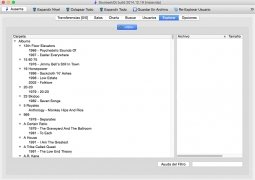

- #Soulseekqt everything queued software#
- #Soulseekqt everything queued code#
- #Soulseekqt everything queued license#
- #Soulseekqt everything queued professional#
Basically, a product is offered Free to Play (Freemium) and the user can decide if he wants to pay the money (Premium) for additional features, services, virtual or physical goods that expand the functionality of the game.
#Soulseekqt everything queued license#
This license is commonly used for video games and it allows users to download and play the game for free.
#Soulseekqt everything queued software#
There are many different open source licenses but they all must comply with the Open Source Definition - in brief: the software can be freely used, modified and shared. Programs released under this license can be used at no cost for both personal and commercial purposes.
#Soulseekqt everything queued code#
Open Source software is software with source code that anyone can inspect, modify or enhance.
#Soulseekqt everything queued professional#
Freeware products can be used free of charge for both personal and professional (commercial use). I remember after Halo 3 came out, the general consensus was that the games' ending essentially left Master Chief in statis to symbolize putting his story on hold until the time was ready for a Halo 4.Freeware programs can be downloaded used free of charge and without any time limitations. In fact, I remember most agreeing that we wouldn't be seeing Chief again in a very long time, so it was pretty surprising to see him return in a game on the same console. And while the legendary ending shows us what is now known to be Requiem, I remember all the speculation that it was either the planet Onyx, a Dyson sphere or a planet of Forerunners. the Master Chief and Cortana, is seen drifting into the Legendary ending of Halo 3. I know Bungie considered making Halo 4 instead of Reach, but just how much of a direction did they have planned between Halo 3 and Reach's development? Was Requiem a 343 idea? Was it something Joseph Staten came up with as a possibility while writing up Halo 3 before relaying it to Frank O'Connor? Halo Infinite Legendary Ending Explained In Detail. Requiem was originally seen in the Legendary epilogue to Halo 3. The ending shows the year 97,368 BCE written on the screen. From what I believe this is the continuation of the ending prelude I discussed above.

A new foreign character is shown in the scene called the ‘Grand Edict’. Paul Russel's testimony is actually very different to what others have said about Bungie's involvement with Halo 4.

I wanted the contract with Microsoft to be a very simple thing. It ended up being that we also needed to give them Halo 4. That wasn’t a bad thing-we needed more money to be independent. This is the Halo Infinite Legendary Ending after the cutscenes. But there was also a middle game that was going to happen between Halo 3 and Halo 4. This is unique as the ending changes depending on which difficulty you play on. This is the Halo Infinite Secret Ending that is. There was a period where we were going to work on a game with Peter Jackson. We had what we called the three buckets-Halo 3, the Peter Jackson game, and Halo 4. We had to fill those three buckets in order to be completely independent, and own our own IP. We officially became our own business around then, but we still had our contractual obligations with Microsoft. Jackson first came to visit the studio in 2005, and we kept talking to him during the next year. Joe and Paul were primarily the guys he spoke with, while the rest of us were thinking about whatever Halo 4 was going to be. It wasn’t going to feature Master Chief, and it’d be a short story, just an expansion pack. You know, some new multiplayer maps and a whole bunch of things that had been scattered through the entire series, all in one package. That would fulfill our contract with Microsoft.


 0 kommentar(er)
0 kommentar(er)
